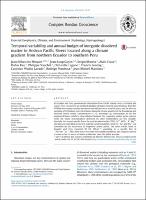Mostrar el registro sencillo del ítem
Temporal variability and annual budget of inorganic dissolved matter in Andean Pacific Rivers located along a climate gradient from northern Ecuador to southern Peru
| dc.contributor.author | Moquet, J.S. | |
| dc.contributor.author | Guyot, J.L. | |
| dc.contributor.author | Morera, S. | |
| dc.contributor.author | Crave, A. | |
| dc.contributor.author | Rau, P. | |
| dc.contributor.author | Vauchel, P. | |
| dc.contributor.author | Lagane, C. | |
| dc.contributor.author | Sondag, F. | |
| dc.contributor.author | Lavado-Casimiro, W. | |
| dc.contributor.author | Pombosa, R. | |
| dc.contributor.author | Martinez, J.-M. | |
| dc.date.accessioned | 2019-07-20T00:42:45Z | |
| dc.date.available | 2019-07-20T00:42:45Z | |
| dc.date.issued | 2018-02 | |
| dc.identifier.uri | http://repositorio.senamhi.gob.pe/handle/20.500.12542/45 | |
| dc.description.abstract | In Ecuador and Peru, geochemical information from Pacific coastal rivers is limited and scarce. Here, we present an unedited database of major element concentrations from five HYBAM observatory stations monitored monthly between 4 and 10 years, and the discrete sampling of 23 Andean rivers distributed along the climate gradient of the Ecuadorian and Peruvian Pacific coasts. Concentration (C) vs. discharge (Q) relationships of the five monitored basins exhibit a clear dilution behavior for evaporites and/or pyrite solutes, while the solute concentrations delivered by other endmembers are less variable. Spatially, the annual specific fluxes for total dissolved solids (TDS), Ca2+, HCO3 −, K+, Mg2+, and SiO2 are controlled on the first order by runoff variability, while Cl−, Na+ and SO4 2− are controlled by the occurrence of evaporites and/or pyrite. The entire Pacific basin in Ecuador and Peru exported 30 Mt TDS·yr−1, according to a specific flux of ∼70 t·km−2·yr−1. This show that, even under low rainfall conditions, this orogenic context is more active, in terms of solute production, than the global average. | es_US |
| dc.format | application/pdf | es_PE |
| dc.language.iso | eng | es_PE |
| dc.publisher | Elsevier Masson SAS | es_PE |
| dc.relation.ispartof | urn:issn:1631-0713 | |
| dc.rights | info:eu-repo/semantics/openAccess | es_PE |
| dc.rights | Reconocimiento - No comercial - Compartir igual (CC BY-NC-SA) | es_PE |
| dc.rights.uri | https://creativecommons.org/licenses/by-nc-sa/4.0/ | es_PE |
| dc.source | Servicio Nacional de Meteorología e Hidrología del Perú | es_PE |
| dc.source | Repositorio Institucional - SENAMHI | es_PE |
| dc.subject | Andes | en_US |
| dc.subject | Climate control | en_US |
| dc.subject | Pacific Rivers | en_US |
| dc.subject | Riverine dissolved budget | en_US |
| dc.subject | Ecuador | en_US |
| dc.subject | Pacific Coast [South America] | en_US |
| dc.subject | Peru | en_US |
| dc.title | Temporal variability and annual budget of inorganic dissolved matter in Andean Pacific Rivers located along a climate gradient from northern Ecuador to southern Peru | en_US |
| dc.type | info:eu-repo/semantics/article | es_PE |
| dc.identifier.isni | 0000 0001 0746 0446 | |
| dc.description.peerreview | Por pares | es_PE |
| dc.identifier.doi | https://doi.org/ 10.1016/j.crte.2017.11.002 | |
| dc.source.volume | 350 | es_PE |
| dc.source.initialpage | 76 | es_PE |
| dc.source.endpage | 87 | es_PE |
| dc.source.journal | Comptes Rendus - Geoscience | es_PE |
| dc.description.funding | We thank the two anonymous reviewers for their constructive recommendations under the review process. This work was funded by the French “Institut de recherche pour le développement” (IRD), the French “Institut des sciences de l’univers” (INSU), and the “Observatoire Midi-Pyrénées” (OMP) through the HYBAM Observatory (Hydrogeodynamics of the Amazon basin). We especially thank Pascal Fraizy, Philippe Vauchel, Elisa Armijos, William Santini, Nore Arevalo, the SENAMHI (“Servicio Nacional de Meteorología e Hidrología”, Lima, Peru), the INAMHI (“Instituto Nacional de Meteorología e Hidrología”, Quito, Ecuador), the UNALM (“Universidad Nacional Agraria de La Molina”, Lima, Peru), as well as all members of the Observatory for Environmental Research HYBAM, for providing hydrological, suspended solids, and water chemistry data. | es_PE |
| dc.subject.ocde | https://purl.org/pe-repo/ocde/ford#1.05.11 | es_PE |
| dc.subject.sinia | precipitacion - Clima y Eventos Naturales | es_PE |
| dc.type.sinia | text/publicacion cientifica | es_PE |
| dc.identifier.url | http://repositorio.senamhi.gob.pe/handle/20.500.12542/45 | |
| dc.identifier.url | https://hdl.handle.net/20.500.12542/45 |
Ficheros en el ítem
Este ítem aparece en la(s) siguiente(s) colección(es)
-
Artículo científico [176]









